Nonresonant confocal Raman imaging of DNA and protein distribution in apoptotic cells
- PMID: 12770902
- PMCID: PMC1302978
- DOI: 10.1016/S0006-3495(03)75124-8
Nonresonant confocal Raman imaging of DNA and protein distribution in apoptotic cells
Abstract
Nonresonant confocal Raman imaging has been used to map the DNA and the protein distributions in individual single human cells. The images are obtained on an improved homebuilt confocal Raman microscope. After statistical analysis, using singular value decomposition, the Raman images are reconstructed from the spectra covering the fingerprint region. The data are obtained at a step interval of approximately 250 nm and cover a field from 8- to 15- micro m square in size. Dwell times at each pixel are between 0.5 and 2 s, depending on the nature and the state of the cell under investigation. High quality nonresonant Raman images can only be obtained under these conditions using continuous wave high laser powers between 60 and 120 mW. We will present evidence that these laser powers can still safely be used to recover the chemical distributions in fixed cells. The developed Raman imaging method is used to image directly, i.e., without prior labeling, the nucleotide condensation and the protein distribution in the so-called nuclear fragments of apoptotic HeLa cells. In the control (nonapoptotic) HeLa cells, we show, for the first time by Raman microspectroscopy, the presence of the RNA in a cell nucleus.
Figures





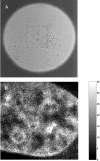

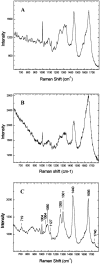
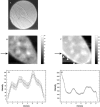
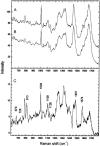
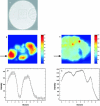
Similar articles
-
Combined Raman and continuous-wave-excited two-photon fluorescence cell imaging.Opt Lett. 2003 Nov 1;28(21):2073-5. doi: 10.1364/ol.28.002073. Opt Lett. 2003. PMID: 14587819
-
Hybrid confocal Raman fluorescence microscopy on single cells using semiconductor quantum dots.Nano Lett. 2007 Jun;7(6):1631-6. doi: 10.1021/nl0705945. Epub 2007 May 3. Nano Lett. 2007. PMID: 17474784
-
Tip-enhanced optical spectroscopy.Philos Trans A Math Phys Eng Sci. 2004 Apr 15;362(1817):807-19. doi: 10.1098/rsta.2003.1348. Philos Trans A Math Phys Eng Sci. 2004. PMID: 15306495 Review.
-
Nonresonant Raman imaging of protein distribution in single human cells.Biopolymers. 2003;72(1):1-9. doi: 10.1002/bip.10246. Biopolymers. 2003. PMID: 12400086
-
Coherent anti-stokes Raman scattering microscopy: a biological review.Cytometry A. 2006 Aug 1;69(8):779-91. doi: 10.1002/cyto.a.20299. Cytometry A. 2006. PMID: 16752420 Review.
Cited by
-
Progress in Raman spectroscopy in the fields of tissue engineering, diagnostics and toxicological testing.J Mater Sci Mater Med. 2006 Nov;17(11):1019-23. doi: 10.1007/s10856-006-0438-6. Epub 2006 Nov 22. J Mater Sci Mater Med. 2006. PMID: 17122913 Review.
-
Progress in exosome associated tumor markers and their detection methods.Mol Biomed. 2020 Aug 14;1(1):3. doi: 10.1186/s43556-020-00002-3. Mol Biomed. 2020. PMID: 35006428 Free PMC article. Review.
-
Microfluidic approaches for isolation, detection, and characterization of extracellular vesicles: Current status and future directions.Biosens Bioelectron. 2017 May 15;91:588-605. doi: 10.1016/j.bios.2016.12.062. Epub 2016 Dec 30. Biosens Bioelectron. 2017. PMID: 28088752 Free PMC article. Review.
-
Paclitaxel distribution in poly(ethylene glycol)/poly(lactide-co-glycolic acid) blends and its release visualized by coherent anti-Stokes Raman scattering microscopy.J Control Release. 2007 Oct 8;122(3):261-8. doi: 10.1016/j.jconrel.2007.05.007. Epub 2007 May 17. J Control Release. 2007. PMID: 17574291 Free PMC article.
-
p-Cresol and C. difficile: A Love-Hate Story Revealed by Raman Spectroscopy.Anal Chem. 2025 Aug 5;97(30):16583-16592. doi: 10.1021/acs.analchem.5c02927. Epub 2025 Jul 23. Anal Chem. 2025. PMID: 40698931 Free PMC article.
References
-
- Arikan, S., H. S. Sands, R. G. Rodway, and D. N. Batchelder. 2002. Raman spectroscopy and imaging of beta-carotene in live corpus luteum cells. Anim. Reprod. Sci. 71:249–266. - PubMed
-
- Biggiogera, M., M. G. Bottone, and C. Pellicciari. 1998. Nuclear RNA is extruded from apoptotic cells. J. Histochem. Cytochem. 46:999–1005. - PubMed
-
- Byassee, T. A., W. C. Chan, and S. Nie. 2000. Probing single molecules in single living cells. Anal. Chem. 72:5606–5611. - PubMed
-
- Cheng, J.-X., A. Volkmer, L. D. Book, and X. S. Xie. 2001. An epi-detected anti-Stokes Raman scattering (E-CARS) microscope with high spectral resolution and high sensitivity. J. Phys. Chem. B. 105:1277–1280.
-
- Cheng, J.-X., A. Volkmer, L. D. Book, and X. S. Xie. 2002. Multiplex coherent anti-Stokes Raman scattering microspectroscopy and study of lipid vesicles. J. Phys. Chem. B. 106:8493–8498.
Publication types
MeSH terms
Substances
LinkOut - more resources
Full Text Sources
Other Literature Sources

